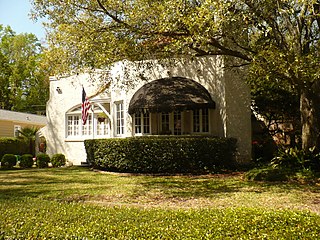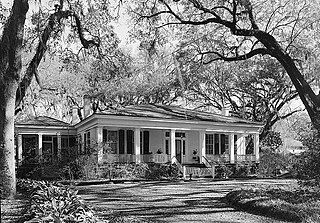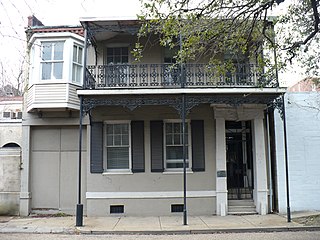
Mobile is the county seat of Mobile County, Alabama, United States. The population within the city limits was 195,111 as of the 2010 United States Census, making it the third-most-populous city in Alabama, and the most populous in Mobile County.

The steamboat Ticonderoga is one of two remaining side-paddle-wheel passenger steamers with a vertical beam engine of the type that provided freight and passenger service on America's bays, lakes and rivers from the early 19th to the mid-20th centuries. Commissioned by the Champlain Transportation Company, Ticonderoga was built in 1906 at the Shelburne Shipyard in Shelburne, Vermont on Lake Champlain.

Harriet Tubman National Historical Park is a US historical park in Auburn and Fleming, New York, associated with the life of Harriet Tubman. It comprises three properties: the Harriet Tubman Home for the Aged, in Auburn; the nearby Harriet Tubman Residence ; and the Thompson A.M.E. Zion Church in Auburn. They are located at 180 and 182 South Street, and 90 Franklin Street, respectively. The Zion Church unit is administered by the National Park Service (NPS), while the South Street properties, including a historic barn and a visitor center, are jointly managed and operated by both the NPS and the Harriet Tubman Home, Inc. The church also works with the NPS in park operations. The Harriet Tubman Grave in nearby Fort Hill Cemetery is not part of the park.

The Wade Askew House is a historic residence in Mobile, Alabama, United States. It was built in 1927 in the Spanish Colonial Revival style. The building was placed on the National Register of Historic Places on July 12, 1991. It is a part of the Spanish Revival Residences in Mobile Multiple Property Submission.

The George Levy House is a historic house located in Mobile, Alabama.

The Ernest Megginson House is a historic house located in Mobile, Alabama.

The J. E. Paterson House is a historic residence in Mobile, Alabama, United States. It was built in 1929 in the Spanish Colonial Revival style. The building was placed on the National Register of Historic Places on July 12, 1991. It is a part of the Spanish Revival Residences in Mobile Multiple Property Submission.

The Arthur VanderSys House is a historic residence in Mobile, Alabama, United States. It was built in 1926 in the Spanish Colonial Revival style. The building was placed on the National Register of Historic Places on July 12, 1991. It is a part of the Spanish Revival Residences in Mobile Multiple Property Submission.

The Jacob VanderSys House is a historic residence in Mobile, Alabama, United States. It was built in 1927 in the Spanish Colonial Revival and Mission Revival styles. The building was placed on the National Register of Historic Places on July 12, 1991. It is a part of the Spanish Revival Residences in Mobile Multiple Property Submission.

The Joseph M. Walker House is a historic residence in Mobile, Alabama, United States. It was built in 1927 in the Spanish Colonial Revival style. The building was placed on the National Register of Historic Places on July 12, 1991. It is a part of the Spanish Revival Residences in Mobile Multiple Property Submission.

The George Fearn House is a historic residence in Mobile, Alabama, United States. It was built in 1904 in the Spanish Colonial Revival style by local architect George Bigelow Rogers. It was the first Spanish Colonial Revival building to be built in Mobile. The house was placed on the National Register of Historic Places on July 12, 1991. It is a part of the Spanish Revival Residences in Mobile Multiple Property Submission.

The Cavallero House is a historic residence in Mobile, Alabama. It was built in 1835 in the Federal style. A cast-iron gallery was added in the mid-19th century. The house was added to the National Register of Historic Places on October 7, 1982. In addition to be individually listed in the National Register, the house is also a contributing building to the Lower Dauphin Street Historic District.

There are nine historic districts in Meridian, Mississippi. Each of these districts is listed on the National Register of Historic Places. One district, Meridian Downtown Historic District, is a combination of two older districts, Meridian Urban Center Historic District and Union Station Historic District. Many architectural styles are present in the districts, most from the late 19th century and early 20th century, including Queen Anne, Colonial Revival, Italianate, Art Deco, Late Victorian, and Bungalow.

Georgia Cottage, also known as the Augusta Evans Wilson House, is a historic residence in Mobile, Alabama, United States. It was added to the National Register of Historic Places on September 14, 1972, based on its association with Augusta Jane Evans. She was one of the most popular American novelists of the nineteenth century and the first female author in the United States to earn over $100,000 for her work, but has been largely forgotten in recent times.

The Paterson House is a historic residence in Mobile, Alabama, United States. The 8,000-square-foot (740 m2) Mediterranean Revival style house was completed in 1927. It was designed by local architect Platt Roberts, who later designed Mobile's 16-story Waterman Building. It was added to the National Register of Historic Places on May 15, 1986, based on its architectural significance.

The Phillipi House, also known as the Mastin House, is a historic residence in Mobile, Alabama, United States. The two-story brick masonry structure was completed in 1850. It is built in a traditional Mobile townhouse style with a Greek Revival door surround and a second floor cast iron balcony across the front elevation. It was added to the National Register of Historic Places on January 5, 1984, based on its architectural significance.

George Bigelow Rogers (1870–1945) was an American architect, best known for the wide variety of buildings that he designed in Mobile, Alabama, including mansions in historic European styles and other private residences, churches and public buildings, and the first 11-story skyscraper in Mobile and the Southeast United States. Many of his structures have been listed on the National Register of Historic Places.

The Mary and Eliza Freeman Houses are historic residences at 352-4 and 358-60 Main Street in Bridgeport, Connecticut. The simple, clapboard-covered dwellings were built in 1848 in what became known as Little Liberia, a neighborhood settled by free blacks starting in the first quarter of the nineteenth century. As the last surviving houses of this neighborhood on their original foundations, these were added to the National Register of Historic Places on February 22, 1999. The houses are the oldest remaining houses in Connecticut built by free blacks, before the state completed its gradual abolition of slavery in 1848. The homes and nearby Walter's Memorial A.M.E. Zion Church are also listed sites on the Connecticut Freedom Trail.

Topsmead State Forest is a Connecticut state forest located in the town of Litchfield. It was formerly the summer residence of Edith Morton Chase, daughter of Henry Sabin Chase, first president of the Chase Brass and Copper Company. She left the house and its grounds to the state of Connecticut on her death in 1972. The estate house, built in 1929 to a design by RIchard Henry Dana, is a fine example of a Tudor Revival country estate house, and is listed on the National Register of Historic Places.

The Codman Carriage House and Stable is a historic building located at 1415 22nd Street NW in the Dupont Circle neighborhood of Washington, D.C. The industrial building was constructed in 1907 as a carriage house and stable for socialite and art collector Martha Codman Karolik, who lived a few blocks north in the Codman–Davis House. The Second Empire style building was designed by Karolik's cousin, architect, and prominent interior decorator Ogden Codman Jr., who also designed her home.

























